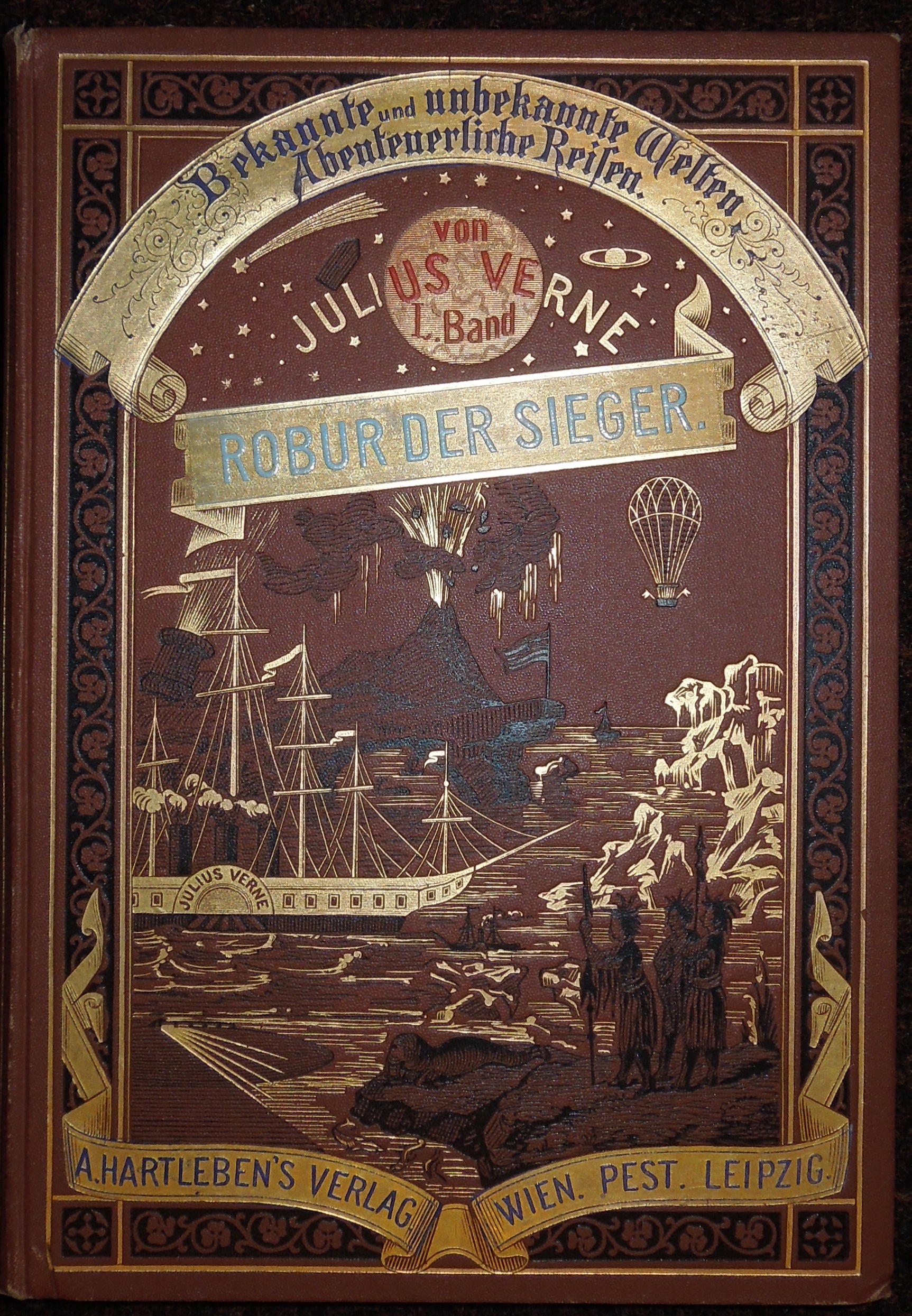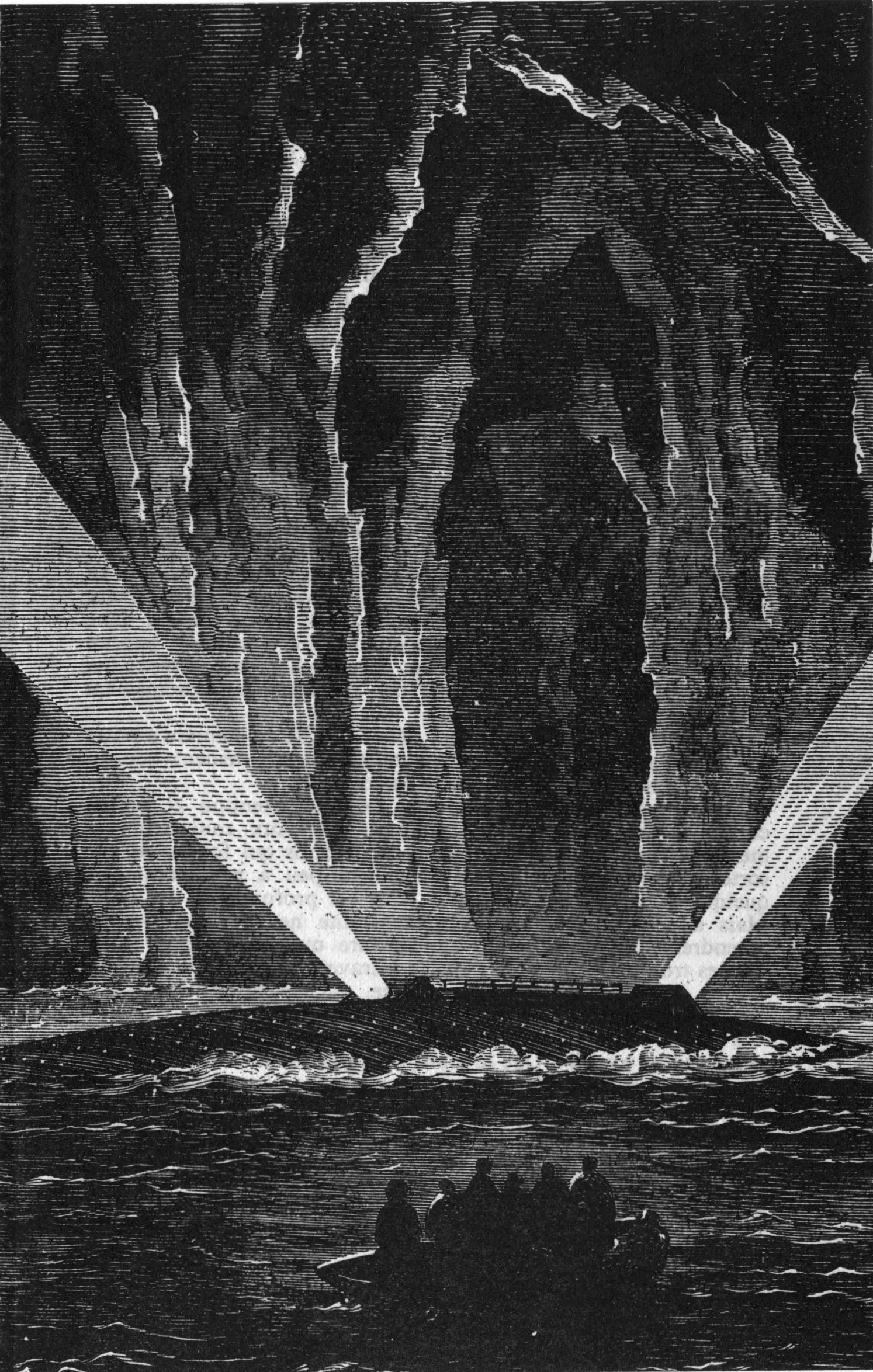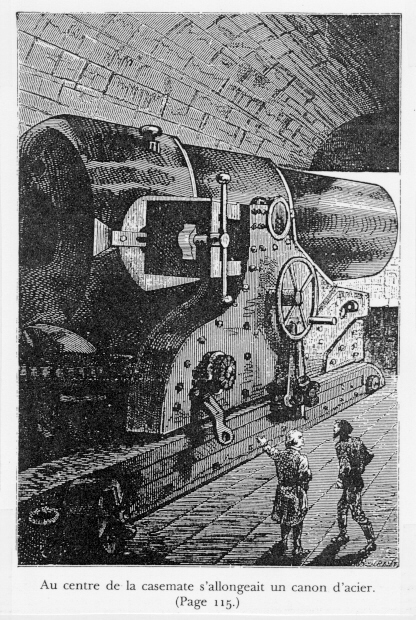
December 30, 2013, by Brigitte Nerlich
Jules Verne: Making science visual
On Christmas Eve I had a chance encounter on twitter and the result is this blog post, or rather: essay. Richard Ashcroft had retweeted a tweet about a book by Adam Roberts. The tweet by Adam Roberts said: “Finished copies came by this morning’s post. Very lovely piece of book making!” The book retells Jules Verne’s story of Twenty Thousand Leagues under the Sea and contains new illustrations by Mahendra Singh. I have now ordered the book, entitled Twenty Trillion Leagues under the Sea, and will get it by the end of January. I am looking forward to reading it.
This tweet and some tweets exchanged with Mahendra Singh brought back memories of a short dissertation I wrote some thirty yeas ago, as part of the German teachers exam, on the illustrations in Jules Verne’s work. Verne has stayed with me ever since, but I hadn’t really thought about the illustrations for quite some time.
For me Jules Verne is not just one of the fathers of science fiction, but also one of the fathers of science communication; and to communicate science he used words and pictures. He collaborated with scientists, artists and, most importantly, book illustrators.
Voyages Extraordinaires
Between the middle of the 19th and the very beginning of the 20th century, Jules Verne (1828-1905) wrote about sixty novels describing advances in science, technology and the exploration of ‘known and unknown’ worlds. These were the Voyages Extraordinaires, which Verne first wanted to call ‘roman de la science’. The novels were commissioned by the publisher Pierre-Jules Hetzel who also founded the Bibliothèque illustrée des Familles (“The Family Illustrated Library”), which was renamed Le Magasin d’éducation et de récréation (“Education and Entertainment Magazine”) in 1864. Hetzel’s goal was to have scientists, authors, and illustrators collaborating to create educational works for the whole family- and the Voyages, which first appeared in Hetzel’s magazine, fulfilled that aim gloriously.
Some of the best-known novels within the Voyages series are From the Earth to the Moon, Twenty Thousand Leagues under the Sea, Around the World in Eighty Days and Journey to the Center of the Earth. They became popular not only because they were fantastic adventure stories intermingled with science and technology, but also because they contained charming illustrations. (Illustration below of the Nautilus by Jules Férat for the Mysterious Island.)
Éducation et Récréation
 Verne’s novels were supposed to teach children (and parents) in an entertaining way about the wonders of the world as seen through the eyes of heroes of science and technology (geographers, mathematicians, astronomers, and engineers). These scientific adventurers used balloons, submarines, rafts, boats, trains, sledges, flying ships, rockets and so on to explore the world from the air, across land and under water, from the North Pole to the South Pole and everything in between, including the centre of the earth. They even travelled to the moon on a rocket-pulled train. These are stories of a world conquered by science and technology, but they also foreshadow some thoughts on what one may call ‘responsible innovation’.
Verne’s novels were supposed to teach children (and parents) in an entertaining way about the wonders of the world as seen through the eyes of heroes of science and technology (geographers, mathematicians, astronomers, and engineers). These scientific adventurers used balloons, submarines, rafts, boats, trains, sledges, flying ships, rockets and so on to explore the world from the air, across land and under water, from the North Pole to the South Pole and everything in between, including the centre of the earth. They even travelled to the moon on a rocket-pulled train. These are stories of a world conquered by science and technology, but they also foreshadow some thoughts on what one may call ‘responsible innovation’.
The illustrations
Most of the novels were originally illustrated with “woodblock engravings, chromolithographs, and chromotypographs, an early technology for color printing photographs”; some late works contain photographs. A dozen or so illustrators worked for Hetzel and Verne. Amongst them Léon Benett (1839-1917) was by far the most important one and created about 2,000 illustrations (see Evans, 1998). Another illustrator, Édouard Riou, who produced the images for Twenty Thousand Leagues under the Sea, was a student of the more famous Gustave Doré who illustrated the The Rime of the Ancient Mariner. That’s the closest Verne, the science populariser, came to being illustrated by a celebrity artist/illustrator. The task set for Verne by his editor was, after all, not to produce high literature (which might deserve illustrations by Doré), but to educate while entertaining. Some of Verne’s illustrators also worked for popular science and travel journals, such as the famous Magasin Pittoresque and Le Tour du Monde.
Interestingly, Verne himself scoured science and travel magazines in order to find suitable images for his stories. In 1874 for example he wrote to his editor: “Je viens de parcourir la collection du Tour du Monde d’Hachette. Voilà les seuls éléphants que je puisse offrir. Il y en a des grands et des petits.” (“I have looked through the collection of the Tour du Monde by Hachette. Here are the only elephants I can offer you. There are big ones and small ones”) And in 1879 he wrote: “L’éléphant de Benett n’est pas assez gigantesque.” (Benett’s elephant is not gigantic enough”) (Taussat, 1974). Science and spectacle merged in Verne’s novel, and in this process light and lighting play an important role.
The light fantastic
When we look back now at the novels and their illustrations, it feels like exploring a museum of our technoscientific imagination. The people, landscapes, technologies, animals and objects contained in this quaint museum are illuminated by a large variety of light sources, from the sun to the moon, from gas and electric light to the northern lights and the ‘green ray’. The novels make the ideal of scientific ‘enlightenment’ real and public and bring science, technology and exploration to new ‘publics’, indeed directly into their homes. They make the invisible and inaccessible visible and accessible, a tradition continued today from space.
When reading Verne’s novels thirty years ago, I was fascinated by the use of light in the texts and images, especially in novels playing at the North Pole, such as The Adventures of Captain Hatteras (see illustrations by Riou, top and right) (and the South Pole, An Antarctic Mystery). Some of the them reminded me of the images used by the French astronomer and science communicator Camille Flammarion in his 1866 book Real and imaginary worlds. However, behind this 19th-century romance of science and technology, readers can also find a more realistic portrait of science that is quite enlightening.
A realistic look at science
As Timothy Unwin noted in an article written in 2005: “In a one-off piece on Jules Verne, Michel Foucault once claimed that the best scientists in Verne’s work are the ones who make mistakes and thus reveal their humanity […], rather than those who coldly calculate with unswerving logic. Foucault’s argument carries the clear implication that error and inaccuracy, as a central part of Verne’s system, are a necessary stage in the discovery of knowledge, since knowledge is only relative and can only be a process of gradual correction of previous errors. As Lidenbrock points out to Axel in Journey to the Center of the Earth, ‘science, my boy, is made up of errors’“.
From techno-optimism to techno-pessimism
 One aspect of Verne’s work is sometimes forgotten. Verne’s novels normally project an image of techno-enthusiasm (that’s what his editor and readers wanted). However, in his later novels Verne began to express a certain techno-scepticism, and his last novels grapple with the darker side of science and technology and the impacts of science on society. Two novels in particular were more dystopian in nature. One was written in 1889 as a sequel to From the Earth to the Moon, and entitled The Purchase of the North Pole. The novel describes a plan, quite topical nowadays, to change the tilt of the Earth’s axis in order to gain access to vast coal deposits that were thought to exist under the ice. The other is the 1879 novel The Begum’s Fortune. Here a German and a French scientist create two utopian cities in the United States. However, Verne describes the emergence of racial hatred, nationalism and warfare which included the use novel technologies, such as poison gas and super-cannons (illustration by Benett, left). In the end the German ‘Stahlstadt’ is destroyed, partly because of scientific mistakes made by its founder, and is taken over by the triumphant inhabitants of ‘Franceville’. Master of the World, written in 1904, just before Verne’s death, was another dark novel in which Verne reflected on the danger of totalitarianism.
One aspect of Verne’s work is sometimes forgotten. Verne’s novels normally project an image of techno-enthusiasm (that’s what his editor and readers wanted). However, in his later novels Verne began to express a certain techno-scepticism, and his last novels grapple with the darker side of science and technology and the impacts of science on society. Two novels in particular were more dystopian in nature. One was written in 1889 as a sequel to From the Earth to the Moon, and entitled The Purchase of the North Pole. The novel describes a plan, quite topical nowadays, to change the tilt of the Earth’s axis in order to gain access to vast coal deposits that were thought to exist under the ice. The other is the 1879 novel The Begum’s Fortune. Here a German and a French scientist create two utopian cities in the United States. However, Verne describes the emergence of racial hatred, nationalism and warfare which included the use novel technologies, such as poison gas and super-cannons (illustration by Benett, left). In the end the German ‘Stahlstadt’ is destroyed, partly because of scientific mistakes made by its founder, and is taken over by the triumphant inhabitants of ‘Franceville’. Master of the World, written in 1904, just before Verne’s death, was another dark novel in which Verne reflected on the danger of totalitarianism.
Science, popularisation and illustration
The popularisation of science by writers and illustrators is one aspect of ‘making science public’. The history such activities began arguably in the 17th century with Bernard le Bovier de Fontenelle‘s Conversations on the Plurality of Worlds. However, the 19th century saw the first professional science popularisers at work, amongst them (in France) Camille Flammarion, Jules Verne and also Louis Figuier, the editor in chief of La Science illustrée, a popular science journal to which Verne and Flammarion contributed.
Verne became famous, but we should not forget illustrators like Benett and Riou (who also illustrated Figuier’s 1863 popular science book La Terre avant le déluge) as part of this history of science popularisation. Without them it would have been much less fun to see and explore the world through the eyes of scientists, engineers and adventurers. More seriously, these ‘fantastic voyages‘ would have been much less popular and their appeal would have been less enduring without these illustrations. Popularising science and visualising science go hand in hand, and they still do today.
Note: For a good overview of Verne’s work see Evans, 1988; and on the illustrations in particular Marcucci, 1956, Robin, 1978, and Evans 1998. The source for the quotes was: Taussat, Robert – Le surhomme et son lecteur. Europe. P. 143-148. Vol. 52. No 542. June 1974.
Note: I have pursued this topic a bit more in an other post called ‘Making science picturesque‘.
Featured image: My German copy of Robur the Conquerer (Robur der Sieger) from 1887


[…] such as imaginary voyages, utopian and dystopian fiction and adventure stories. And, of course, Jules Verne’s work belongs to this […]
[…] Aaah, I reminisced, I once owned a copy of this popular science magazine when I was researching the illustrations in Jules Verne’s work for a little student dissertation I wrote in the 1980s. This in turn set me thinking about […]
[…] from early editions in the 1860s to later ones in the early 20th century. I have previously written a blog post about some aspects of these images and the ways they make science both public and […]
[…] kind, but related again to images. The illustrated edition of this adventure book is full of lithographs representing not only the heroes of the book but, most importantly, what they see when venturing […]
I’ve recently visited Dinard, France and found some beautiful mosaic plaques of Verne’s books. I asked tourist information why they were here seeing as he grew up in Nantes but everyone shrugged their shoulders. I guess when you are the second most translated author in the world you don’t need to be restricted to a postcode when you’re a national treasure. Brilliant article by the way. Thanks.
Ah, that made me curious, as I only had some vague memory of Verne and Dinard (I studied him a bit in the 1980s); so I dug a bit and found this – apparently he went there quite frequently!
http://www.ville-dinard.fr/module-pagesetter-viewpub-tid-2-pid-14.html
Thanks for that ‘trouvaille’ and I am glad you liked the post!